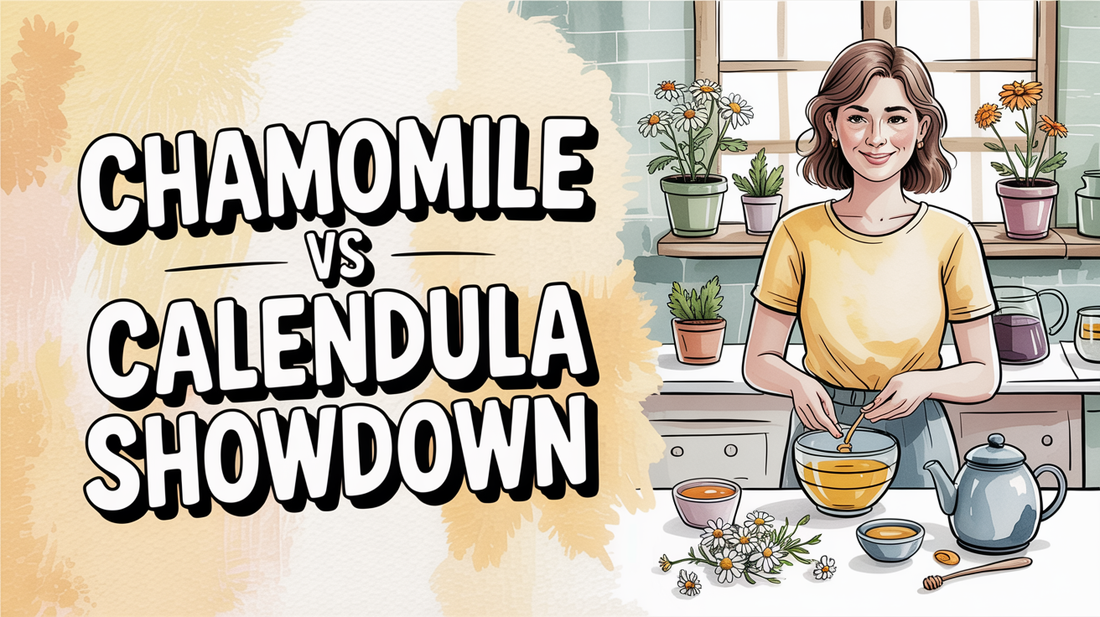Chamomile vs. Calendula: Which Flower Is Best for Skin Health?
chamomile vs calendula, calendula cream, herbal skincare — As you explore the best herbal options for your skin, understanding the differences between chamomile and calendula can guide you in choosing the right products. This post is organized into three clear sections, each highlighting the unique benefits of these flowers and how they can fit into your skincare routine.
The Benefits of Chamomile
Chamomile is a gentle herb cherished for its skin-soothing properties, making it a beloved ingredient in herbal skincare. This daisy-like flower features anti-inflammatory compounds that may help calm irritated skin and reduce redness. If you’re looking for a gentle touch in your skincare, chamomile might be your go-to.
Here are some key benefits of chamomile for skin health:
- Anti-inflammatory properties that may help soothe skin irritation.
- Supports gentle healing, making it suitable for sensitive skin.
- Rich in antioxidants, which can protect against environmental damage.
- Natural antimicrobial effects that may help maintain skin balance.
- Moisturizes dry skin, providing hydration when needed.
Chamomile is available in various forms like teas, oils, and creams, making it easy to include in your daily routine. Its long history in traditional medicine showcases its well-established safety profile, allowing you to explore its benefits with confidence.
The Benefits of Calendula ✨
Calendula, known as pot marigold, is a striking orange flower recognized for its efficacy in skin healing. Unlike chamomile, calendula is especially praised for its wound-healing properties, making calendula cream a common staple in natural medicine cabinets. Its vibrant color is just a hint of the vibrant benefits it offers for skin health.
Some of the key advantages of calendula include:
- May support superior wound healing, helping to repair cuts and scrapes.
- Effective anti-inflammatory action that may reduce swelling and discomfort.
- Antimicrobial properties that help combat bacteria and fungi.
- Ideal for damaged or severely dry skin, including sunburn relief.
- Promotes skin regeneration, which can aid in scar reduction.
Many people find that incorporating calendula into their routine can be as simple as using a cream after a shower to soothe and repair the skin. It is gentle enough for all ages and is often recommended for both children and adults.
Why We Recommend a Gentle Helper 🌿
Jane Vine Calendula Cream is formulated for quick absorption and a soothing, lightweight feel. It may support a calm routine and help reduce skin irritation.
- Fast-absorbing and unscented.
- Skin-soothing ingredients.
- Inspired by Nature.
Which One Works Better for You 🔍
When deciding between chamomile and calendula for your skincare needs, it’s essential to consider your specific concerns and skin type. Both herbs offer unique benefits, and you may find that using them together enhances your skincare routine.
Here are some guiding points to help you choose the right flower for your skin:
- Chamomile is ideal for sensitive skin, while calendula suits resilient skin needing more intensive care.
- If your concerns involve general inflammation, chamomile may be the better choice; for cuts and severe dryness, calendula is recommended.
- For mild skin issues, chamomile's gentle properties often suffice; for faster healing, calendula's strengths shine.
- Both products are suitable for various ages, but chamomile tends to be favored for babies and the elderly.
- Consider your product preference: lighter chamomile formulations or thicker calendula creams for targeted treatment.
Whether you choose chamomile for daily care or calendula cream for specific issues, each flower can bring soothing support to your skincare journey.

